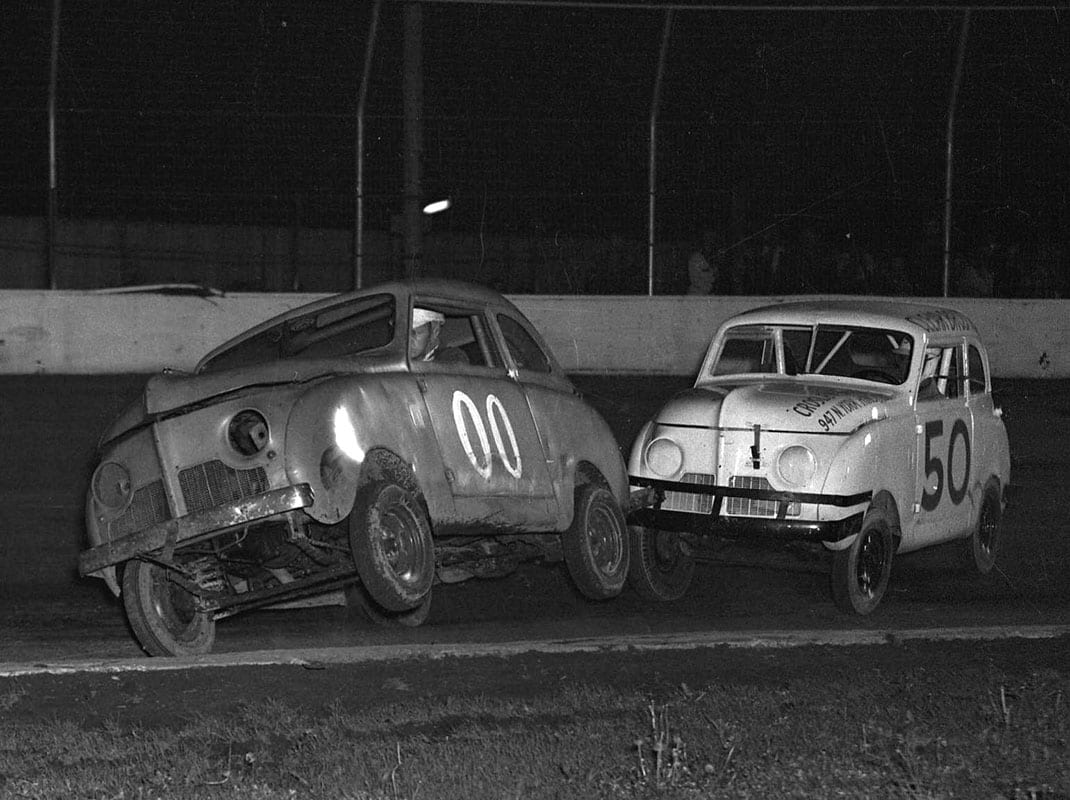Back in the early 1950s, Crosley stock car racing became part of the weekly motorsports schedule in the “Windy City” region.
Beginning in 1952, short tracks, like Cole Lenzi Field, Mance Park, 87th Street Speedway, Raceway Park, Soldier Field and indoors at the International Amphitheatre, began to host the small-car action.
The diminutive Crosley automobile was produced from about 1939 through 1952 in the cities of Richmond and Marion, Ind., with the company, owned by Powel Crosley Jr., headquartered in Cincinnati. Crosley, an innovative individual, at one time owned the Cincinnati Reds baseball team and a Cincinnati radio station.
On average, the car measured about 12-feet long from bumper to bumper and weighed between 1,100 and 1,400 pounds. An air-cooled, two-cylinder engine powered the vehicle. Featuring rounded lines in a sedan, convertible or station wagon model, the car was rather narrow at about 49 inches with a wheelbase of about 80 inches.
Crosley racing debuted around Chicago in 1952 at Cole Lenzi Field, an athletic/baseball facility located west of Chicago in Hodgkins, Ill. With the racing presented at the small dirt oval by the Chicago Crosley Racing Ass’n, competition saw midget racer Lou Scally, Carl Clark, Gil Miranda, Bernie Siewak, “Runt” Stanover and Tom Norbert among the feature winners. Dan Fredericks was crowned the champion.
Clark and Siewak were team, which also included Cy Hooper and one of the Clear brothers from time to time — either Spike or Red. The Clear brothers operated a Crosley dealership/repair shop on York Road in Hinsdale, Ill. The team cars were numbered 50 through 53 and painted white with red lettering.

At Soldier Field on Chicago’s lakefront, Bob Leatherman raced a Crosley against the full-sized stock cars during the weekly Andy Granatelli-promote racing programs at the flat, quarter-mile, paved oval. Leatherman, a former football star, wheeled his No. ½ to starter Art Kelly’s checkered flag in a 25-lap feature victory at Soldier Field in front of some 14,000 fans on July 9, 1952. No doubt the small wheelbase of the Crosley helped the Chicago driver maneuver the tight Soldier Field turns.
The little cars also competed at Raceway Park and 87th Street Speedway in 1952 with weekly racing moving to Mance Park Speedway beginning in 1953. An early May opening date was scheduled with the racing to be held under the auspices of the West Suburban Racing Ass’n.
More Crosley racing took place in 1954 at Mance Park, which was located at 63rd Street and East Avenue in Hodgkins — less than a mile south of Cole Lenzi. Raceway Park also hosted the little cars on several occasions.
In January 1954, the Crosley stockers competed one-time-only indoors at the International Amphitheatre, which was located at 42nd Street and Halsted right next to Chicago’s famed Stockyards. On Jan. 16, Chicago’s George Piper won a 50-lap feature on the Amphitheatre concrete oval ahead of local midget champion Tony Lenti, Al Schueneman and Clear Brothers driver Clark.
The races were presented by the Chicago Auto Racing Ass’n, which was headed by Granatelli.
Ed James, who would later own a Chevrolet dealership in the western suburbs of Chicago, remembers the Crosley racing at Cole Lenzi and was instrumental in getting the racing at the Amphitheatre to become a reality.
“In 1952, they were racing the Crosleys at the Cole-Lenzi ball diamond,” remembered James. “The cars were actually running around the bases. I heard about the races and went out and bought a used Crosley station wagon. I put a roll bar in it and welded up the spider gears to have a locking rear end. I didn’t start racing until I turned 21 in July.
“I was the secretary or treasurer of the West Suburban Racing Ass’n when they raced at Mance,” James added. “I distributed the winnings and was in charge of the pit passes. Cliff Woodbury Jr. (son of 1920s Indianapolis driver Cliff Woodbury) and I grew up together and he got involved in Crosley racing after I did and drove some for the Clear Brothers.
“Cliff and I got together with Andy Granatelli, who controlled Chicago auto racing (at Soldier Field) and was running the midgets inside the Amphitheatre during the winter,” James noted. “We got a contract with him to run the Crosleys in place of the midgets on a Saturday. After doing all that work, I was drafted and on a train the night before (the races) headed to Fort Leonard Wood (Mo.) for basic training.
“They ran the Crosleys that night and my girlfriend (wife-to-be) wrote me a 15-page letter about the races. They called them the ‘Crunching Crosleys.’ The people in the stands were standing most of the time because it turned out to be almost a demolition derby.”
Seemingly as quick as Crosley racing hit the Chicago area, the small-car competition was pretty much over by 1955 — some three years after the last Crosley automobile came off the assembly line.
